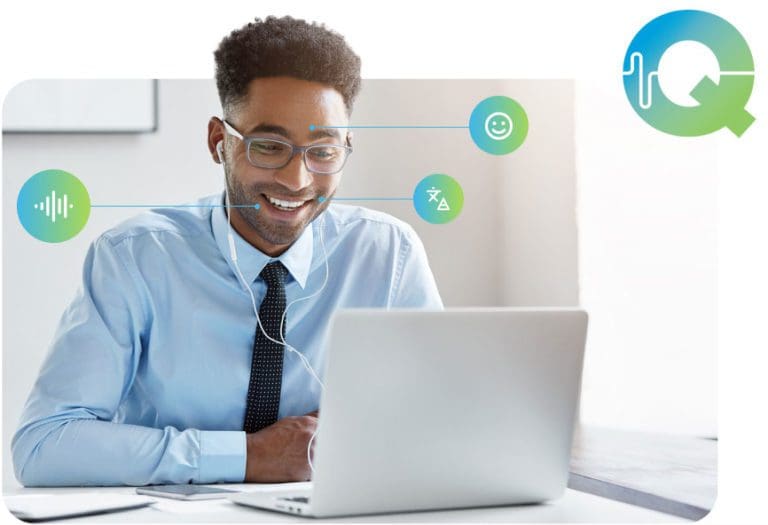There are some words I don’t use lightly. Groundbreaking, innovative, unprecedented—these terms are thrown around so frequently (and so carelessly) that they almost lose their meaning. So, when we unveiled our newest solution—Q for Sales—earlier this month at Uniphore Converse 2022, I had to remind myself that it was okay to use such language. In fact, it was the right time. Q is groundbreaking. It is the first of its kind. This wasn’t hyperbole, it was a fact.

Indeed, there is no other solution on the market that can combine video, voice, tone and contextual cues to offer a complete analysis of every conversation – the new currency of the enterprise. Our Q for Sales product uses a combined approach of computer vision, natural language processing (NLP), automated speech recognition (ASR) and audio-based tonal and sentiment analysis to identify context and key moments like no other conversational intelligence solution available today.
Moreover, with this product launch – the result of adding video AI and computer vision to our portfolio with last year’s Emotion Research Labs acquisition – we’ve expanded our capacity to help businesses improve far beyond the contact center and to determine engagement and sentiment on video calls. Through Q for Sales, Uniphore is capitalizing on the paradigm shift in how businesses communicate with their prospects, customers and teams in our modern, virtual – and video-heavy – workplaces.
One of the biggest values Q for Sales provides in our digital world: it allows sales and revenue personnel the ability to “read the room,” in video calls—sensing emotional cues and identifying the key moments that influence sentiment, engagement and ultimately the EQ (emotional intelligence) factors that influence decisions.
“You may be thinking, “how does privacy and security factor in here? My customers’ engagement and emotions are going to be analyzed?...And are they going to be okay with that??” I want to address these types of questions – right away. ”
Umesh Sachdev, CEO of Uniphore
We know that trust and transparency are of critical importance to our customers, and those same principles form the cornerstone of how we treat our customers’ data. As we built Q for Sales, we anticipated these concerns because we, too, care passionately about privacy. To answer these questions, we’ll need to dive deeper into the type of data Q for Sales uses and how it secures it against misuse and outside threats.
What type of data does Q for Sales capture?
Q for Sales uses computer vision, automated speech recognition and natural language processing to capture every element of the human conversation. This includes facial expressions, gestures, spoken and written words, attentiveness and sentiment based on verbal and non-verbal datapoints. In other words, Q collects and analyzes the same type of data our human brain does when we interact face to face—only Q does this remotely and with remarkable accuracy.
How does Q for Sales use this data?
 Q for Sales applies this data to our emotion Fusion Metrics to calculate the real-time emotional state of each participant in a video meeting. These EQ calculations appear in the seller dashboard to help meeting leaders gauge—and respond to—emotional cues from their audience. For example, if one or more participants seem distracted or disengaged, Q for Sales will alert the seller, who can then change course to reengage part of or the whole group. The entire interaction, including EQ data, can also be revisited later for coaching, training and quality assurance purposes. Likewise, with Q for Sales’ help to transcribe buyer intent and emotion – while converting it to actionable recommendations that answer the buyer’s needs – our Q product doesn’t just benefit the seller but translates to happier, more satisfied buyers as well.
Q for Sales applies this data to our emotion Fusion Metrics to calculate the real-time emotional state of each participant in a video meeting. These EQ calculations appear in the seller dashboard to help meeting leaders gauge—and respond to—emotional cues from their audience. For example, if one or more participants seem distracted or disengaged, Q for Sales will alert the seller, who can then change course to reengage part of or the whole group. The entire interaction, including EQ data, can also be revisited later for coaching, training and quality assurance purposes. Likewise, with Q for Sales’ help to transcribe buyer intent and emotion – while converting it to actionable recommendations that answer the buyer’s needs – our Q product doesn’t just benefit the seller but translates to happier, more satisfied buyers as well.
How does Q for Sales protect the data it uses?
Simple gestures, facial expressions and subtle vocal inflections can provide critical insight about how we feel at any given time. In face-to-face interactions, we read and respond to these nonverbal cues without thinking twice. We accept them as a natural part of two-way conversation.

By using technology to capture and convert these observations into data, naturally, questions of data privacy and, subsequently, data security may come up. For Q, we ensured the product’s design follows worldwide data privacy requirements and demonstrates our commitment to the protection of our customers’ data.
SOC2 - A SOC2 (System and Organization Control) report demonstrates the strength of the system and the suitability of the design controls. Design sufficiency of all administrative, technical and logical controls are validated to ensure IT security and usage as a technology-based service organization. SOC2 is a critical security standard in our increasingly cloud-based world.
Vulnerability Scanner – Periodic vulnerability scanning is performed to identify unsecured access points, misconfigurations, password and denial-of service vulnerabilities across a breadth of technologies —from individual devices and operating systems to web servers, databases and other critical infrastructure components.
Container and Application Monitoring – We routinely test and monitor the health of our containerized applications to ensure they are running smoothly and efficiently. This includes collecting metrics, logs and other observable data to learn what is happening at every level of our containerized infrastructure.
In addition to these safeguards, Q for Sales re-certifies its static code certification, dynamic test certification and penetration test certifications every six months. These combined protocols ensure that the data our solution collects is protected not only from external threats but also against vulnerabilities from within an organization’s processes and personnel.
We also follow and implement the recommendations of NIST (the National Institute of Standards and Technology) where relevant, which recently released a draft “AI Risk Management Framework” that has gone out for general comment. NIST’s framework is meant to improve the ability to incorporate trustworthiness considerations into the design, development, use and evaluation of AI products, services and systems. We’ve taken this same mindset of following best practices and standards to incorporate trustworthiness into our solutions and are keeping a pulse on NIST’s framework as it continues to develop.
In today’s hyperconnected world, we believe you can never be too safe when it comes to data security and privacy. Which brings me to another word I don’t use lightly: trust. Trust is everything to us. It’s the foundation of every relationship, and it lends confidence to every interaction. How do we build trust? By being transparent in our practices and fully committed to upholding trust above all else. At Uniphore, that’s something we do every day.
)
 By
By